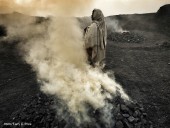Other Lists
Creating Subgroups
The Toxic Twenty span a wide range of issues. Each pollution problem has its own set of particular characteristics that separates it in some way from the others. Some of the problems, like POPs, remain for generations and continue to have a residual impact long after use. Others, like contaminated surface water, have a particularly damaging impact on the health of children.
For this reason we have prepared the smaller lists from the Toxic Twenty. The first of these, “Top Four Least Addressed Pollution Problems,” provides an unranked summary of those least likely to be on public health policy radar. These might equally be called most “Unknown” or “Ignored.” Artisanal Gold Mining is included here, as is Used Lead Acid Battery Recycling. Both of these have far reaching effects - wherever there are cars, there are car batteries – yet there exist few international agencies and limited resources for dealing with them.
The second subgroup “The Top Eight Pollution Problems Affecting Children” importantly draws attention to those toxics that affect the most vulnerable populations.
Some of the worst pollution problems are in many ways products of poverty. High levels of urbanization, lack of infrastructure and formal sector employment, as well as overstretched governments, present very dangerous conditions for human health as people turn to informal - and often toxic – sources of income generation.
Nowhere is this better illustrated than Africa, which bears a hugely disproportionate amount of the global burden of disease. Our third subgroup “The Top Seven Pollution Problems in Africa” highlights some of the problems making the economic development of the world’s poorest continent that much more challenging.
Lastly, we present “The Top Four Pollution Problems Affecting Future Generations.” Some pollutants are particularly persistent, and more likely than others to affect future generations. While others will at the very least decrease in their severity over time, those in this category will not simply go away, and may in many cases, actually get worse. This can happen through “bioaccumulation” the process whereby pollutants increase in severity as they move up the food chain.
The Four Least Addressed Pollution Problems
The Top Four Least Addressed Pollution Problems provides an unranked summary of those least likely to be on public health policy radar. These might equally be called most “Unknown” or “Partially Ignored.” Artisanal Gold Mining is included here, as is Used Lead Acid Battery Recycling. Both of these have far reaching effects -- wherever there are cars, there are car batteries – yet there exist few international agencies and limited resources for dealing with them.
- Artisanal gold mining
- Chromium
- Old and abandoned chemical weapons
- Used lead acid battery recycling
The Top Eight Pollution Problems Most Affecting Children
The Top Eight Pollution Problems Most Affecting Children importantly draws attention to the toxins that affect the most innocent. Children are more susceptible to environmental risks than adults. Children are not just “small adults,” but rather are physiologically different and more vulnerable. By way of illustration, while children only make up 10% of the world’s population, over 40% of the global burden of disease falls on them. Indeed, more than three million children under age five die annually from environmental factors.
- Contaminated sufrace water
- Groundwater contamination
- Indoor air pollution
- Industrial mining activities
- Metals smelting and processing
- Untreated sewage
- Urban air quality
- Used lead acid battery recycling
The Top Seven Worst Pollution Problems in Africa
Some of the Worst Pollution Problems are in many ways products of poverty. High levels of urbanization, lack of infrastructure and formal sector employment, and overstretched governments, present very dangerous conditions for human health. Nowhere is this better illustrated than Africa, which bears a disproportionate amount of the global burden of disease. The Seven Worst Pollution Problems in Africa highlights some of the problems making the economic development of the world’s poorest continent that much more challenging.
- Abandoned mines
- Artisanal gold mining
- Contaminated surface water
- Indoor air pollution
- Oil refineries and petrochemical plants
- Radioactive waste and uranium mining
- Untreated sewage
The Top Four Pollution Problems Most Affecting Future Generations
Some pollutants are particularly persistent, and more likely than others to affect future generations. While others will at the very least decrease in their severity over time, those in this category will not simply go away, and may in many cases, actually get worse. This can happen through “bioaccumulation” the process whereby pollutants increase in concentration and toxicity as they move up the food chain.
- Groundwater contamination
- Old and abandoned chemical weapons
- PCBs
- Radioactive waste and uranium mining





